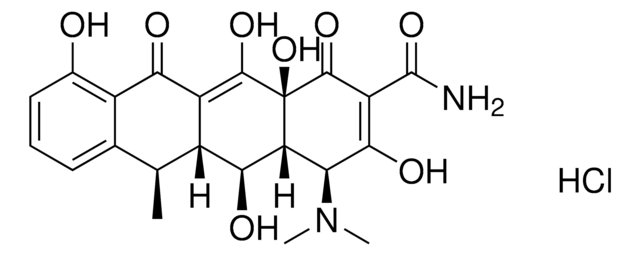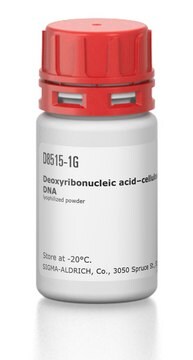Kluczowe dokumenty
D9891
Doxycycline hyclate
Synonim(y):
Półwodzian chlorowodorku 6-dezoksy-5-hydroksytetracykliny
About This Item
Polecane produkty
pochodzenie biologiczne
synthetic
Poziom jakości
Próba
≥93.5% (HPLC)
95.0-102.0% anhydrous basis (ethanol free based)
Formularz
powder
warunki przechowywania
(Tightly closed. Dry. )
kolor
yellow to yellow-green
spektrum działania antybiotyku
Gram-negative bacteria
Gram-positive bacteria
mycoplasma
parasites
Tryb działania
protein synthesis | interferes
temp. przechowywania
2-8°C
ciąg SMILES
Cl[H].Cl[H].[H]O[H].CCO.C[C@@H]1C2[C@H](O)C3[C@H](N(C)C)C(O)=C(C(N)=O)C(=O)[C@@]3(O)C(O)=C2C(=O)c4c(O)cccc14.C[C@@H]5C6[C@H](O)C7[C@H](N(C)C)C(O)=C(C(N)=O)C(=O)[C@@]7(O)C(O)=C6C(=O)c8c(O)cccc58
InChI
1S/2C22H24N2O8.C2H6O.2ClH.H2O/c2*1-7-8-5-4-6-9(25)11(8)16(26)12-10(7)17(27)14-15(24(2)3)18(28)13(21(23)31)20(30)22(14,32)19(12)29;1-2-3;;;/h2*4-7,10,14-15,17,25,27-29,32H,1-3H3,(H2,23,31);3H,2H2,1H3;2*1H;1H2/t2*7-,10?,14?,15-,17-,22-;;;;/m00..../s1
Klucz InChI
HALQELOKLVRWRI-ZVACAFRPSA-N
Szukasz podobnych produktów? Odwiedź Przewodnik dotyczący porównywania produktów
Opis ogólny
Beyond its antimicrobial effects, Doxycycline Hyclate serves as an inhibitor of matrix metalloproteinases (MMPs), enzymes crucial for collagen breakdown in connective tissues. Studies on corneal erosion and rheumatoid arthritis showcase its significant reduction in MMP-9 and MMP-8 levels, respectively. This MMP-inhibiting property helps preserve collagen integrity, preventing excessive tissue degradation and supporting tissue repair.
In cell biology, Doxycycline Hyclate impacts smooth muscle cells, enhancing adhesion and influencing the reorganization of fibrillar collagen matrices. Its influence on apicoplast gene expression in Plasmodium falciparum, the malaria-causing parasite, adds a dimension of significance in infectious disease research. Additionally, the inhibition of tissue formation in rat studies contributes to its relevance in understanding tissue development.
Moreover, Doxycycline Hyclate holds potential in metabolomics research, considering its multi-faceted effects on various cellular processes. In the broader context of biochemical research, its versatile actions make it a valuable tool for investigating molecular mechanisms and signaling pathways.
Zastosowanie
Działania biochem./fizjol.
Activity Spectrum: Effective against a broad spectrum inhibitor of matrix metalloproteinases in vivo.
Cechy i korzyści
- High-quality antibiotic suitable for multiple research applications
- Ideal for Cell Biology, Metabolomics, and Biochemical research.
Inne uwagi
najczęściej kupowane z tym produktem
Hasło ostrzegawcze
Warning
Zwroty wskazujące rodzaj zagrożenia
Zwroty wskazujące środki ostrożności
Klasyfikacja zagrożeń
Acute Tox. 4 Oral - Aquatic Chronic 3 - Eye Irrit. 2 - Repr. 2 - Skin Irrit. 2 - STOT SE 3
Organy docelowe
Respiratory system
Kod klasy składowania
11 - Combustible Solids
Klasa zagrożenia wodnego (WGK)
WGK 3
Temperatura zapłonu (°F)
Not applicable
Temperatura zapłonu (°C)
Not applicable
Środki ochrony indywidualnej
dust mask type N95 (US), Eyeshields, Gloves
Wybierz jedną z najnowszych wersji:
Masz już ten produkt?
Dokumenty związane z niedawno zakupionymi produktami zostały zamieszczone w Bibliotece dokumentów.
Klienci oglądali również te produkty
Nasz zespół naukowców ma doświadczenie we wszystkich obszarach badań, w tym w naukach przyrodniczych, materiałoznawstwie, syntezie chemicznej, chromatografii, analityce i wielu innych dziedzinach.
Skontaktuj się z zespołem ds. pomocy technicznej












